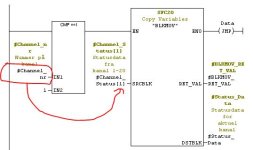JERA
Member
Must modify / expand a program which is made with a many block move (SFC20) as shown in the attached image.
It moves data between array of different data blocks and needs to be expanded. I would like to change the addressing of calling for indirect to get rid of the large number of block move that will come.
Have tried some different solutions but have not found the right one.
So does anyone have the solution to make a ANY pointer for use in array?

It moves data between array of different data blocks and needs to be expanded. I would like to change the addressing of calling for indirect to get rid of the large number of block move that will come.
Have tried some different solutions but have not found the right one.
So does anyone have the solution to make a ANY pointer for use in array?







